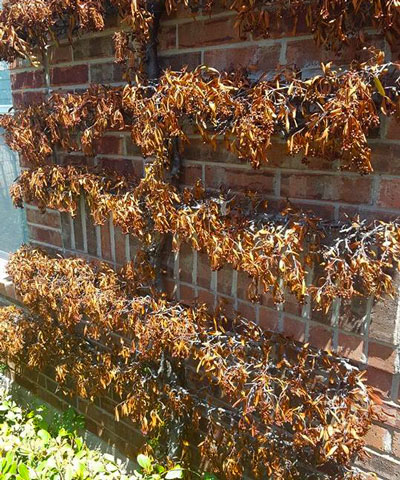Question of the Week Number 1: July 27, 2017
“Neil, what would kill a plant almost overnight? It was perfectly healthy just three weeks ago.”
This is almost assuredly due to the soil-borne fungus known as cotton root rot or Texas root rot. More than 80 percent of our Texas landscape plants are susceptible to it to some degree or another, although you can see that the hollies in the foreground, which share the soil with the pyracantha, are not.

Photo: Cotton root rot selectively killed this old pyracantha espalier. What it took 10 or 15 years for the gardener to train, CRR destroyed almost overnight.
Cotton root rot is found in alkaline soils only, so it’s a problem basically in Texas from I-35 and westward. Anyone who has lived in Texas very long remembers how much cotton used to be grown in the Blackland Prairie, but that has been reduced to a small percentage in the past 30 years, and cotton root rot is the prime reason.
Cotton root rot may lay in waiting in a landscape’s soil for 10 or 20 years before it attacks a susceptible species. That’s obviously what it’s done to this magnificent pyracantha espalier shown in the photo. Can you imagine how many years it took this gardener to develop this plant? Suddenly, for whatever the reasons, conditions became perfect and the disease rose up and took the plant very suddenly. This photo was posted on my Facebook page, and I had to deliver the bad news.
Those of us who do diagnoses for a living soon learn to recognize cotton root rot as soon as we see plants like Bradford pears, apples, Indian hawthorns, lacebark elms and many others going downhill. It will attack the entire plant uniformly – and quickly. If there is a row of the same species, it’s not uncommon for it to move down the row a few feet per year until it has taken all of the plants.
You may be able to slow the progress of this disease by adding a sulfur soil acidifier to the ground. (Remember: it’s a problem only in alkaline soils.) However, that usually plays out and must be repeated. It’s a lot easier to plant resistant or immune species from the outset. Hollies, junipers, nandinas, crape myrtles, oaks, cedar elms and pecans all fall into that category. Otherwise, you just take your chances when you plant susceptible species and hope that maybe your plantings will be spared.
